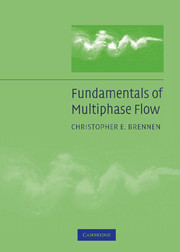Book contents
- Frontmatter
- Contents
- Preface
- Nomenclature
- 1 Introduction to Multiphase Flow
- 2 Single-Particle Motion
- 3 Bubble or Droplet Translation
- 4 Bubble Growth and Collapse
- 5 Cavitation
- 6 Boiling and Condensation
- 7 Flow Patterns
- 8 Internal Flow Energy Conversion
- 9 Homogeneous Flows
- 10 Flows with Bubble Dynamics
- 11 Flows with Gas Dynamics
- 12 Sprays
- 13 Granular Flows
- 14 Drift Flux Models
- 15 System Instabilities
- 16 Kinematic Waves
- Bibliography
- Index
11 - Flows with Gas Dynamics
Published online by Cambridge University Press: 05 June 2014
- Frontmatter
- Contents
- Preface
- Nomenclature
- 1 Introduction to Multiphase Flow
- 2 Single-Particle Motion
- 3 Bubble or Droplet Translation
- 4 Bubble Growth and Collapse
- 5 Cavitation
- 6 Boiling and Condensation
- 7 Flow Patterns
- 8 Internal Flow Energy Conversion
- 9 Homogeneous Flows
- 10 Flows with Bubble Dynamics
- 11 Flows with Gas Dynamics
- 12 Sprays
- 13 Granular Flows
- 14 Drift Flux Models
- 15 System Instabilities
- 16 Kinematic Waves
- Bibliography
- Index
Summary
Introduction
This chapter addresses the class of compressible flows in which a gaseous continuous phase is seeded with droplets or particles and in which it is necessary to evaluate the relative motion between the disperse and continuous phases for a variety of possible reasons. In many such flows, the motivation is the erosion of the flow boundaries by particles or drops and this is directly related to the relative motion. In other cases, the purpose is to evaluate the change in the performance of the system or device. Still another motivation is the desire to evaluate changes in the instability boundaries caused by the presence of the disperse phase.
Examples include the potential for serious damage to steam turbine blades by impacting water droplets (e.g., Gardner 1963, Smith et al. 1967). In the context of aircraft engines, desert sand storms or clouds of volcanic dust can not only cause serious erosion to the gas turbine compressor (Tabakoff and Hussein 1971, Smialek et al. 1994, Dunn et al. 1996, Tabakoff and Hamed 1986) but can also deleteriously effect the stall margin and cause engine shutdown (Batcho et al. 1987). Other examples include the consequences of seeding the fuel of a solid-propelled rocket with metal particles to enhance its performance. This is a particularly complicated example because the particles may also melt and oxidize in the flow (Shorr and Zaehringer 1967).
In recent years considerable advancements have been made in the numerical models and methods available for the solution of dilute particle-laden flows.
- Type
- Chapter
- Information
- Fundamentals of Multiphase Flow , pp. 217 - 231Publisher: Cambridge University PressPrint publication year: 2005

